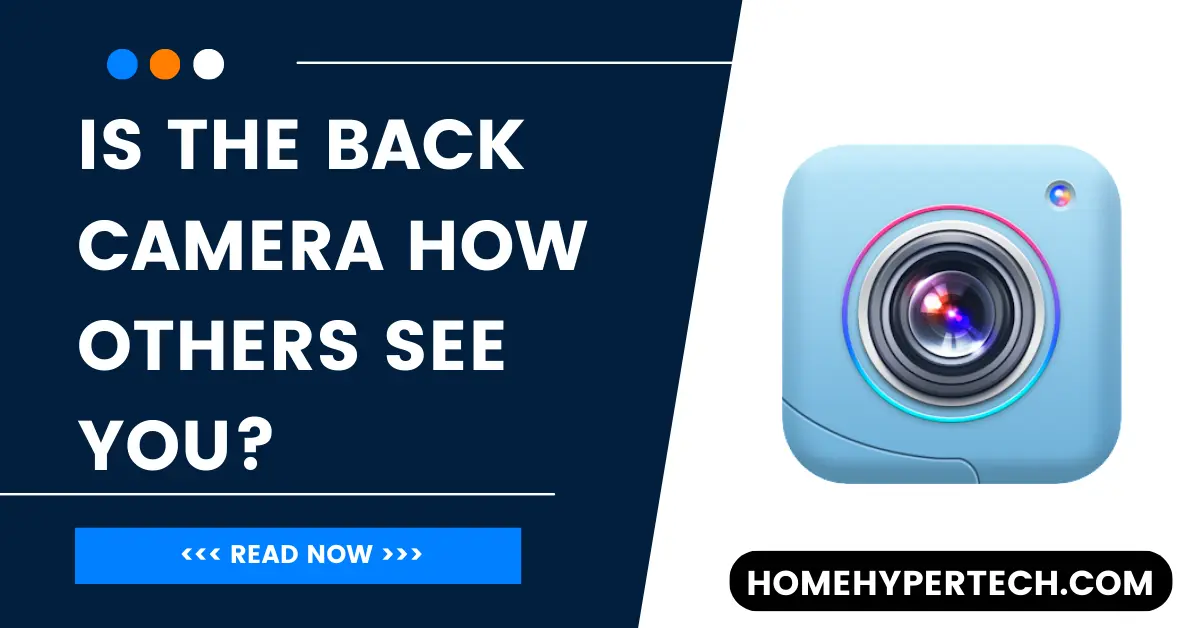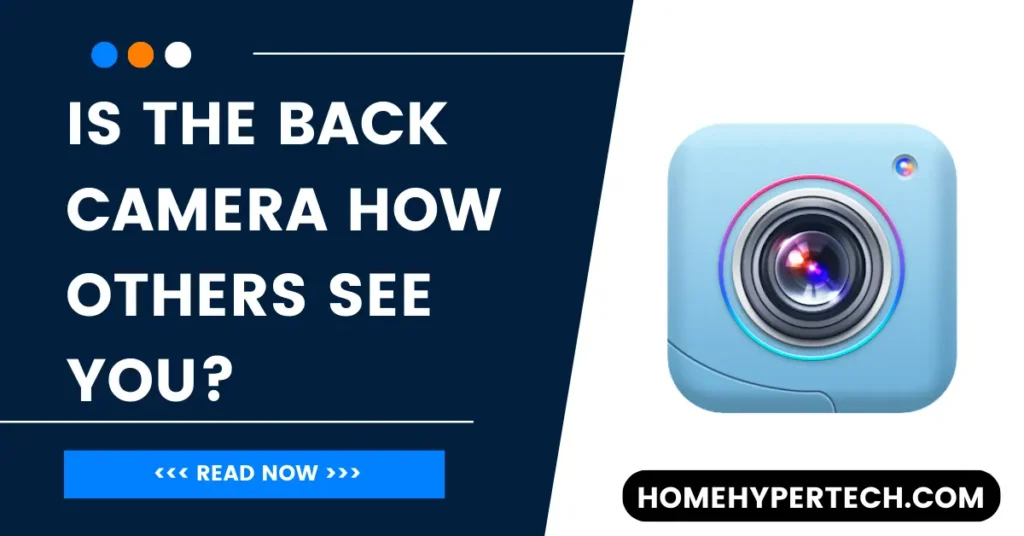Is The Back Camera How Others See You?

In today’s digital age, where social media and selfies have become an integral part of our lives, the concept of self-presentation has taken on a whole new dimension. People are more conscious of their appearance and how they present themselves to the world. With the widespread use of smartphones, the front camera has become a tool for capturing self-portraits, but what about the back camera? Is the back camera how others see you?
In this article, we will explore this question “is the back camera how others see you” and examine into the psychology behind self-perception.
Back Camera vs Front Camera – Understanding the Difference
The back camera and front camera of a smartphone serve different purposes. The front camera is primarily used for taking selfies, allowing individuals to capture images of themselves.
On the other hand, the back camera is used to take photos of the world around us, including other people. This fundamental difference sets the stage for our exploration of self-perception versus how others see us.

The Psychology of Self-Perception
1. How Do We See Ourselves?
Self-perception is a complex psychological process. How we see ourselves is influenced by various factors, including our self-esteem, body image, and social comparison. When using the front camera for selfies, individuals have control over their angles, lighting, and filters, which can significantly impact their self-perception.
2. The Influence of Social Media
Social media platforms have further shaped self-perception. With the ability to share carefully curated images and portray an idealized version of themselves, people often strive for perfection. This can lead to a distorted self-image, as individuals may feel pressured to present themselves in a certain way.
Is the Back Camera How Others See You
On many occasions, you may have noticed a stark difference between the selfies you take and the photos captured using the back camera of your smartphone. This might lead you to wonder which camera accurately depicts how you truly look. The reality is that neither the front camera nor the rear camera can perfectly capture the real you.
When someone sees you in person and compares it to the photos taken with your phone, there will inevitably be some disparities. The reason for this difference lies in the camera’s distortion of your facial features, leading to an image that doesn’t precisely mirror your appearance as seen by others.
Social Applications With Pictures Modification
To add to this complexity, various editing applications and features are readily available, enticing people to modify their pictures before sharing them on social media platforms. These editing tools can drastically alter one’s appearance, sometimes to the point where it becomes challenging to recognize the person in the image. Popular platforms like Instagram, TikTok, and Snapchat offer a wide array of filters that can change facial features, skin tone, and even add virtual accessories.
Front and Back Camera With Application
The camera application itself allows users to tweak settings like brightness, lighting, and more, enabling them to capture high-quality pictures. Despite these enhancements, it is essential to understand that none of these images, whether taken with the front or back camera, can fully represent how other people see you.
Both the front and back cameras contribute to the distortion of your face in some way, making the resulting images different from reality. However, it’s worth noting that the rear camera attempts to provide a more realistic representation, which is closer to how others perceive you in person.
Major Points Which Should be Noted
1. Body Language and Non-Verbal Cues
The back camera not only captures our physical appearance but also our body language and non-verbal cues. These subtle expressions convey emotions and personality traits that might not be as apparent in staged selfies.
2. Perplexity of Self-Image
The disconnect between how we see ourselves (through selfies) and how others see us (through the back camera) creates perplexity. We might be surprised or even uncomfortable with the way others perceive us, especially if it contradicts our self-perception.
3. Embracing Authenticity
Embracing the authentic version of ourselves, as seen through the back camera, can lead to greater self-acceptance and confidence. Recognizing that perfection is unattainable and that imperfections are a part of being human can alleviate the burden of self-doubt.
4. The Impact of Moments
The back camera captures moments as they happen, providing a burst of reality. These candid shots can be powerful and genuine, showing us unfiltered glimpses of ourselves and our lives.
5. Sharing Authentic Moments
Encouraging the use of back-camera shots in social media and sharing authentic moments can create a more genuine online community. Embracing natural beauty and real-life experiences can be liberating and inspiring for others.
Shows You How You Really Look with Mirrors Or Cameras
The question of what shows us how we really look, mirrors or cameras, sparks curiosity. While mirrors reflect our image directly, cameras capture a moment frozen in time. Mirrors provide a live, dynamic view, allowing us to see ourselves as we move. However, cameras present a different perspective, influenced by angles, lighting, and lenses. Both play a crucial role, but cameras can sometimes offer a more objective view. Mirrors show us the real-time version, while cameras freeze a fleeting impression. Ultimately, a combination of both tools helps us form a comprehensive understanding of our appearance, making each equally valuable in revealing how we truly look.
You Look in the Back Camera Accurate?
The image captured by the back camera is not a perfectly accurate representation of your appearance. As mentioned earlier, the back camera’s wide-angle lens can distort facial features and proportions. Moreover, lighting conditions and angles can affect how you look in the photo. While the back camera attempts to provide a more realistic view compared to the front camera, it is still influenced by various factors that might alter your perceived appearance. Remember that self-perception is subjective, and embracing your unique features is essential for building self-confidence.
Conclusion
In conclusion, the back camera offers a unique and authentic perspective of ourselves, allowing others to see us in a more genuine light. While the front camera enables us to present an idealized version of ourselves, it is essential to recognize that the back camera captures moments as they are, showcasing our real selves. Embracing this reality can lead to greater self-awareness, acceptance, and meaningful connections with others.
We hope this article “is the back camera how others see you” have helped you to gain knowledge about the camera and the step by step method to view the image how other people will see you.
Also Read:
- Cheapest Place to Develop Disposable Cameras
- 10 Best Wide Angle Lens for Real Estate Videos in 2023
- Best Height For Security Cameras – Mounting Height Guide
FAQ
Why do I look bad in the back camera?
The way you appear in the back camera can sometimes be less flattering due to several factors. The back camera’s perspective is fixed and might not capture the most flattering angles or lighting. Additionally, smartphone cameras often have wide-angle lenses that can distort facial features, making you appear different from how you see yourself in the mirror. Remember, everyone has unique features, and what you perceive as “looking bad” might be a result of a skewed perspective rather than your actual appearance.
Is the camera that shows how you really look?
Neither the front nor the back camera can show you exactly how you appear in reality. Both cameras have limitations, including distortion, lighting variations, and lens effects. While the front camera allows you to see yourself in real-time, it might flip the image, making it appear reversed from what you see in the mirror. On the other hand, the back camera provides a frozen moment that can be affected by angles and lighting. To get a comprehensive view of your appearance, it’s best to rely on a combination of both cameras and consider the bigger picture.
Are smartphone camera pictures true representations of reality?
Smartphone camera pictures can capture moments and scenes accurately, but they might not always provide a completely true representation due to factors like camera distortion and post-processing effects.
What is camera distortion?
Camera distortion refers to the alteration of an image’s appearance due to various factors, such as lens aberrations and perspective distortion, which can lead to a slightly different depiction of the subject.
Does lighting influence image distortion?
Yes, lighting conditions can affect image distortion. Poor lighting may create shadows or highlights that alter the perception of the subject’s features.

I am a content writer and affiliate marketer with a passion for crafting engaging and informative content that drives traffic and sales. With years of experience in the industry, I have honed my skills in SEO, social media marketing, and email marketing to help businesses reach their target audience and achieve their goals.
